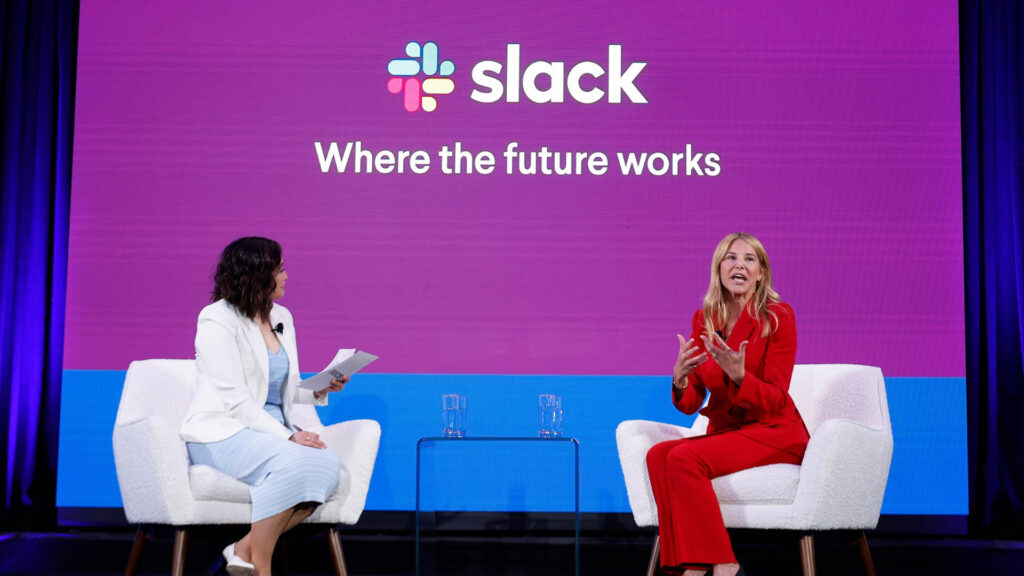
Newsletter Subscribe
Enter your email address below and subscribe to our newsletter

Enter your email address below and subscribe to our newsletter

Discover how Slack is evolving into a comprehensive 'Work Operating System.' This transformation enhances collaboration and productivity for teams everywhere.
Denise Dresser, CEO of Slack, recently outlined the company’s vision to transform Slack into a “work operating system.”
This pivot reflects a shift from being purely a communication tool to becoming a central hub for AI-driven workflows. Integrating AI apps from Salesforce, Adobe, and Anthropic, Slack aims to streamline information retrieval, decision-making, and workflow automation.

With Slack AI, the company introduces premium-tier services like AI-generated huddle summaries and access to Salesforce AI agents for on-demand business data analysis. These features aim to meet the increasing demand for AI in the workspace, where companies seek ways to surface relevant data, automate processes, and improve efficiency.
But will the transition resonate with users, and more importantly, are they willing to pay for it?
Slack’s new AI-powered capabilities include:

These additions are part of Slack’s broader strategy to become indispensable in the AI era. The company’s pitch is that by embedding these tools directly into its interface, Slack can enable more fluid, action-oriented work without requiring users to switch between applications.
The acquisition of Slack by Salesforce in 2021 set the stage for these advancements. Salesforce, now heavily invested in AI across its product suite, sees Slack as the perfect medium to execute its AI vision.
Denise Dresser emphasizes that Slack is a natural fit for AI integration due to its conversational nature, making it a seamless way to interact with AI agents throughout the workday.

Privacy Concerns in Slack’s AI Push
While the new AI features offer enhanced functionality, they also raise concerns. Earlier this year, Slack faced backlash after it was revealed that the platform’s privacy policy allowed customer data to be used for training certain AI models.
Although Slack clarified that it does not use customer data to train its large language models, the incident highlighted the growing concerns around privacy in AI deployments. As more AI functionalities are added, ensuring data security and user trust remains critical for Slack’s long-term success.
The workplace tools market is undergoing a major transformation driven by AI. Following the rise of generative AI tools like ChatGPT, companies are increasingly incorporating AI into their products to stay relevant. However, the value of these integrations depends on their seamless functionality and practical applications in everyday work.
Slack’s push into AI is aligned with broader trends in workplace productivity tools. Microsoft Teams, Google Workspace, and other platforms are integrating AI to enhance collaboration and workflow efficiency. The integration of AI into daily operations has the potential to revolutionize how businesses function, but it also poses challenges related to costs, data privacy, and adoption.
For companies, the choice to invest in these AI-powered solutions comes down to balancing cost with tangible improvements in productivity. Many organizations are still assessing whether AI will deliver the promised efficiencies or simply add complexity to their workflows.
The question remains: Will users embrace Slack’s shift to a more AI-centric work platform, and are they ready to pay for these premium features? While there is certainly excitement around AI, adoption rates could be slow, especially among smaller companies concerned about cost and privacy.
Furthermore, some businesses might prefer to develop in-house AI tools, as evidenced by recent moves from companies like Klarna.
However, as AI continues to shape the future of work, Slack’s strategy to become an AI-powered work operating system may position it well to capture a growing share of enterprise users seeking to optimize their operations.